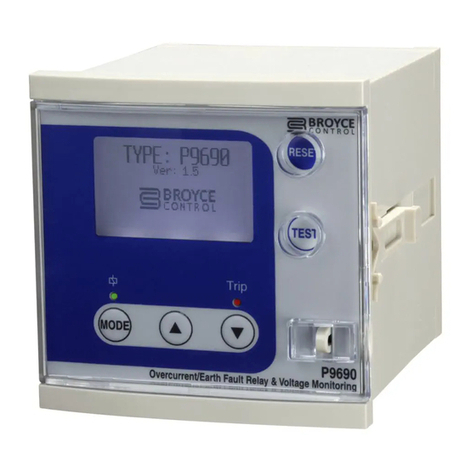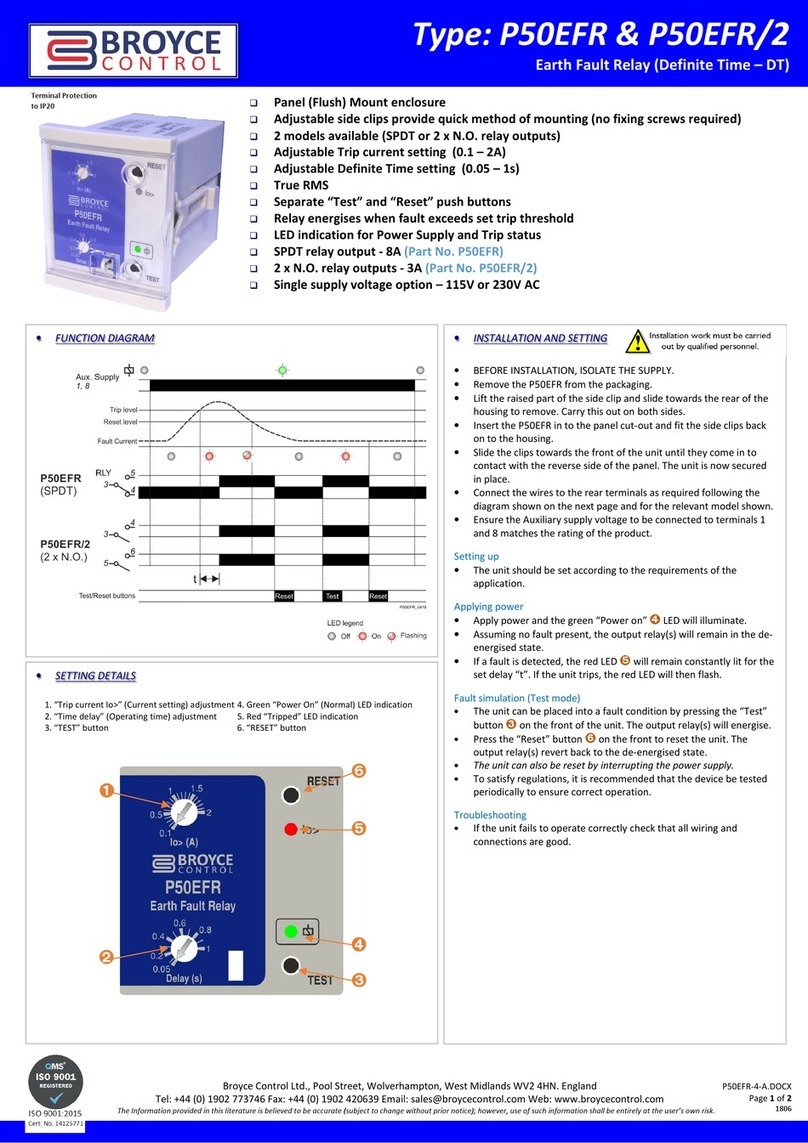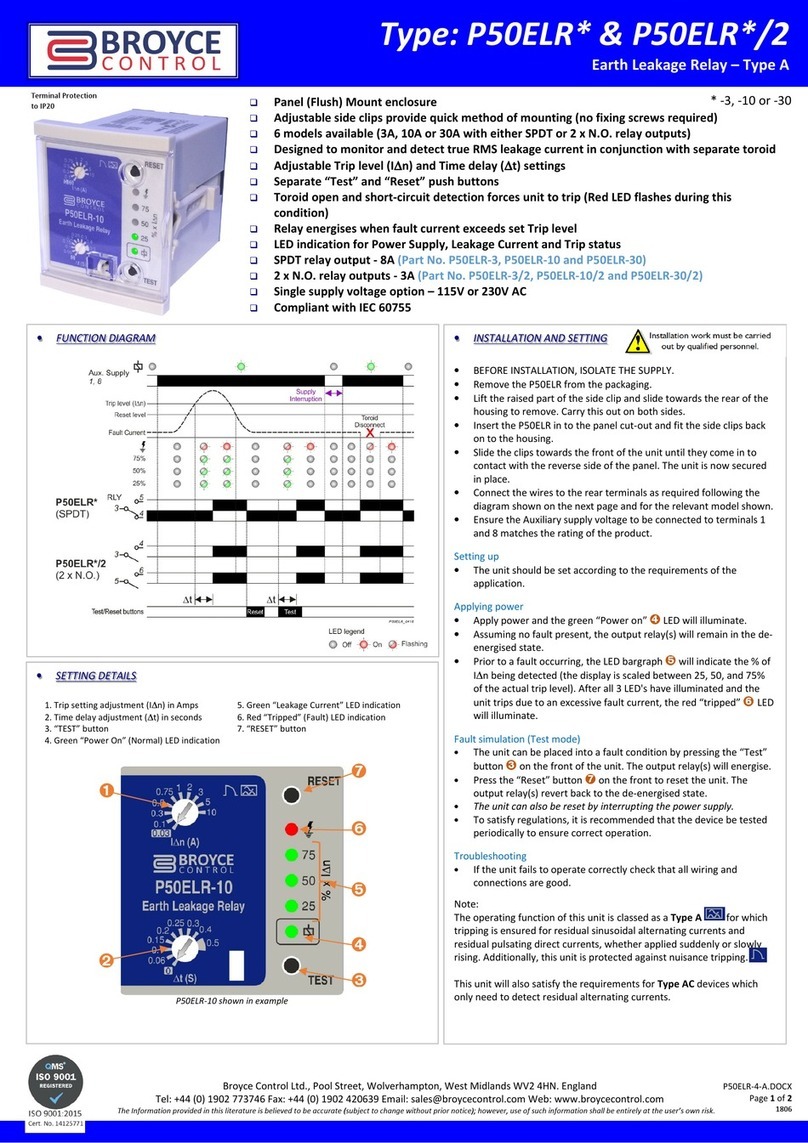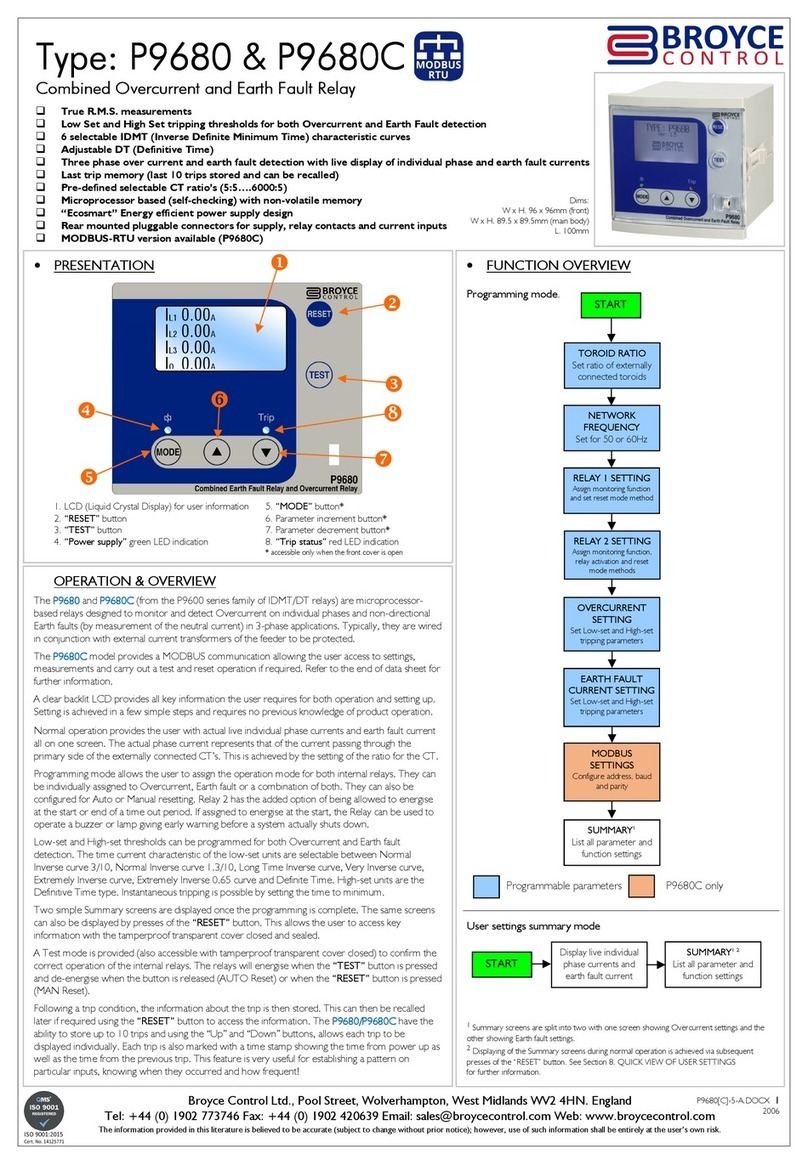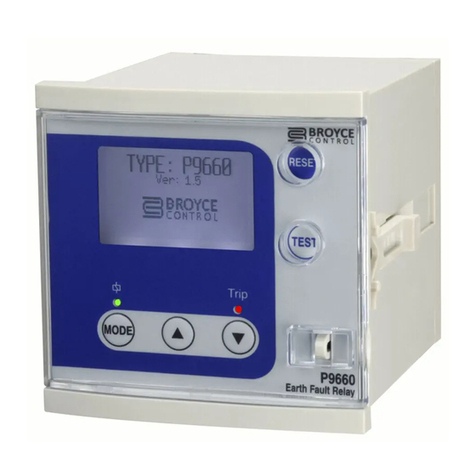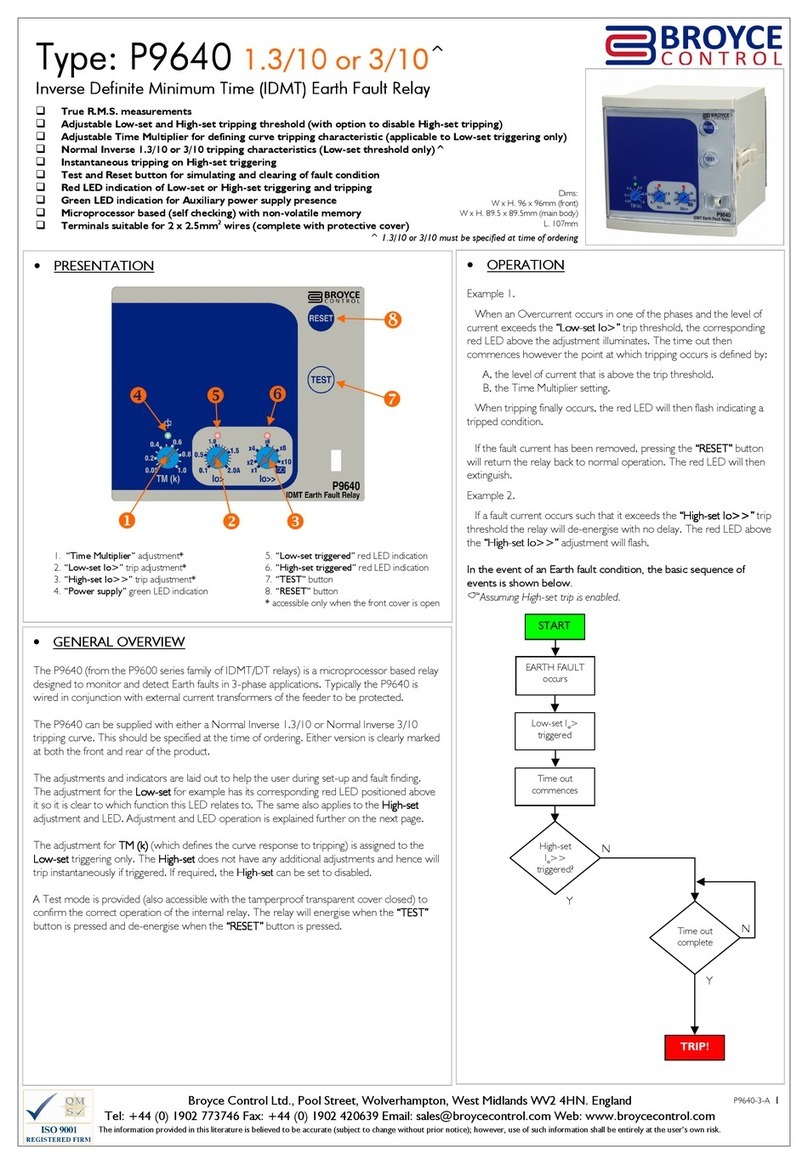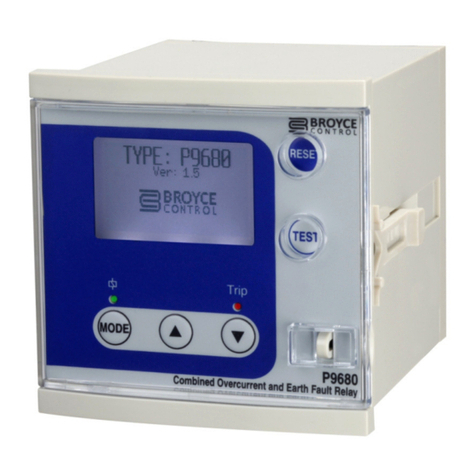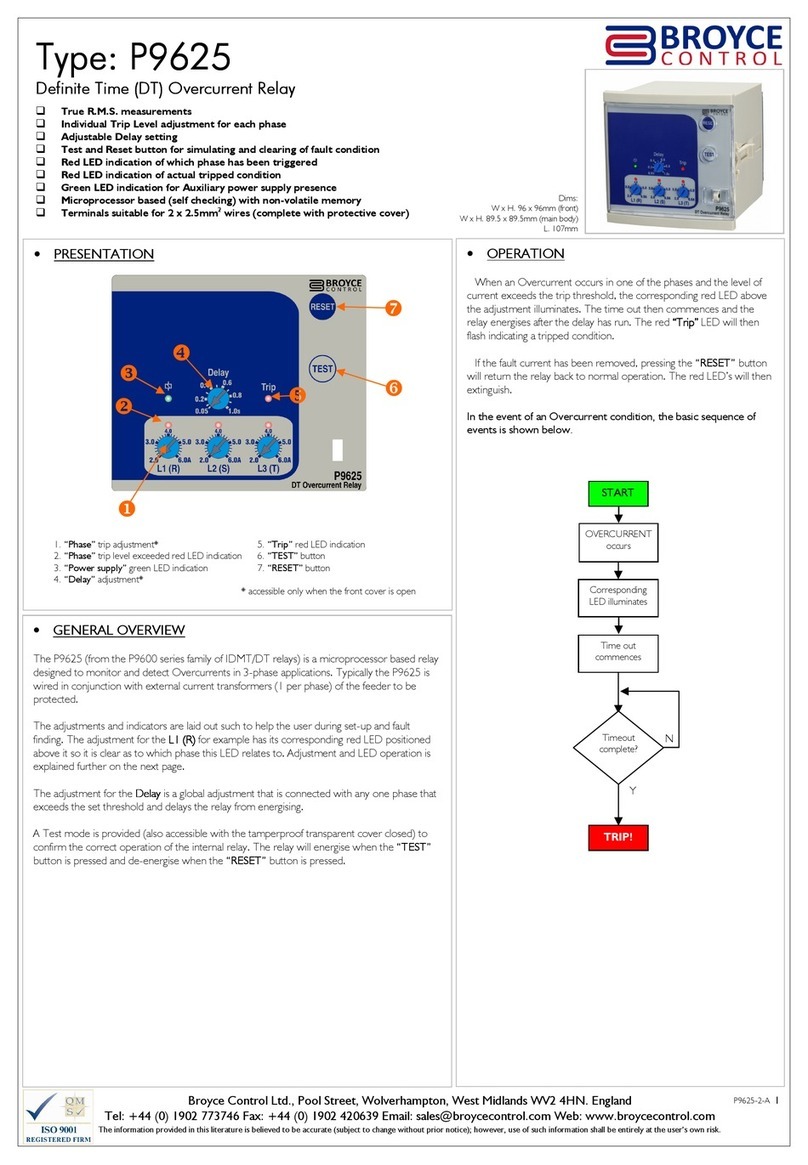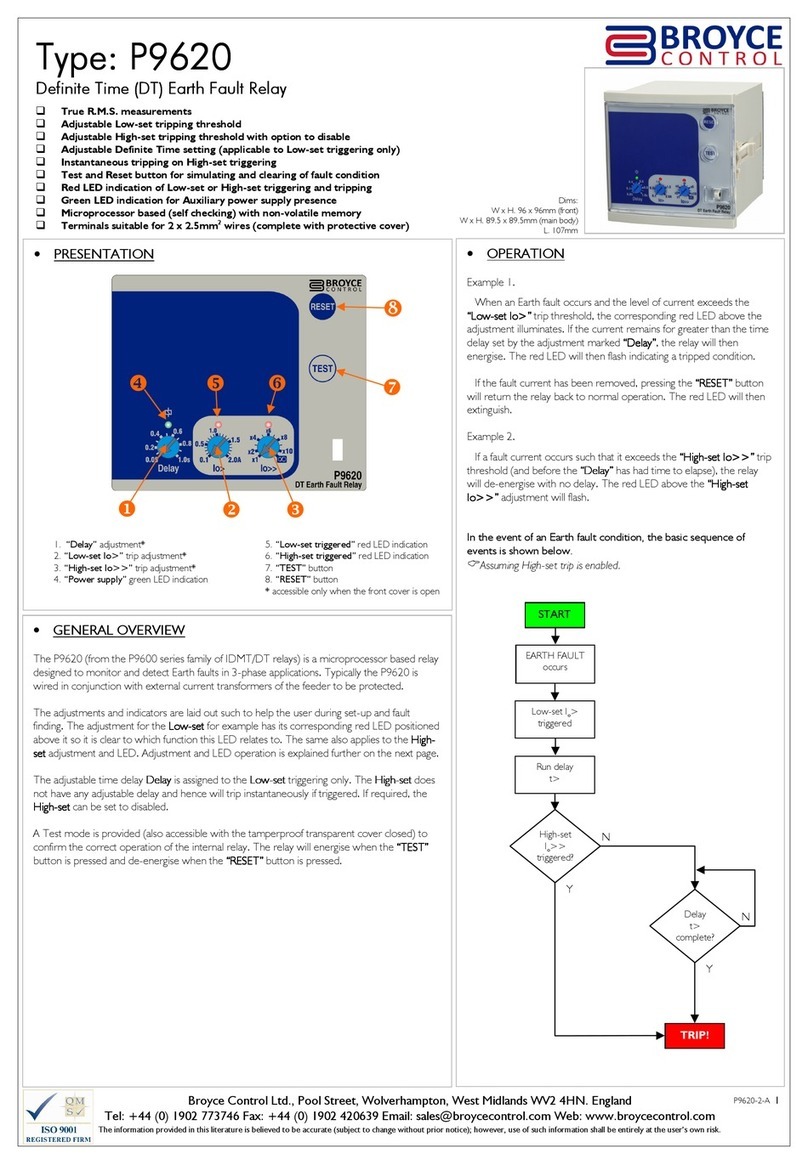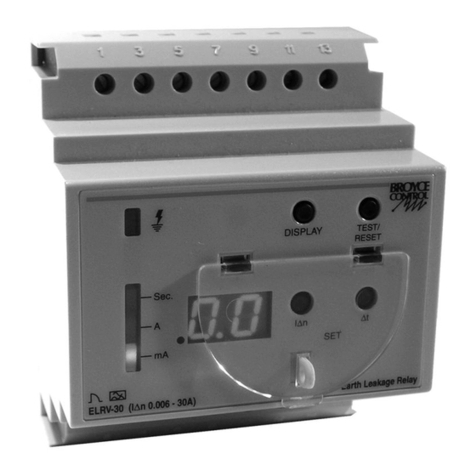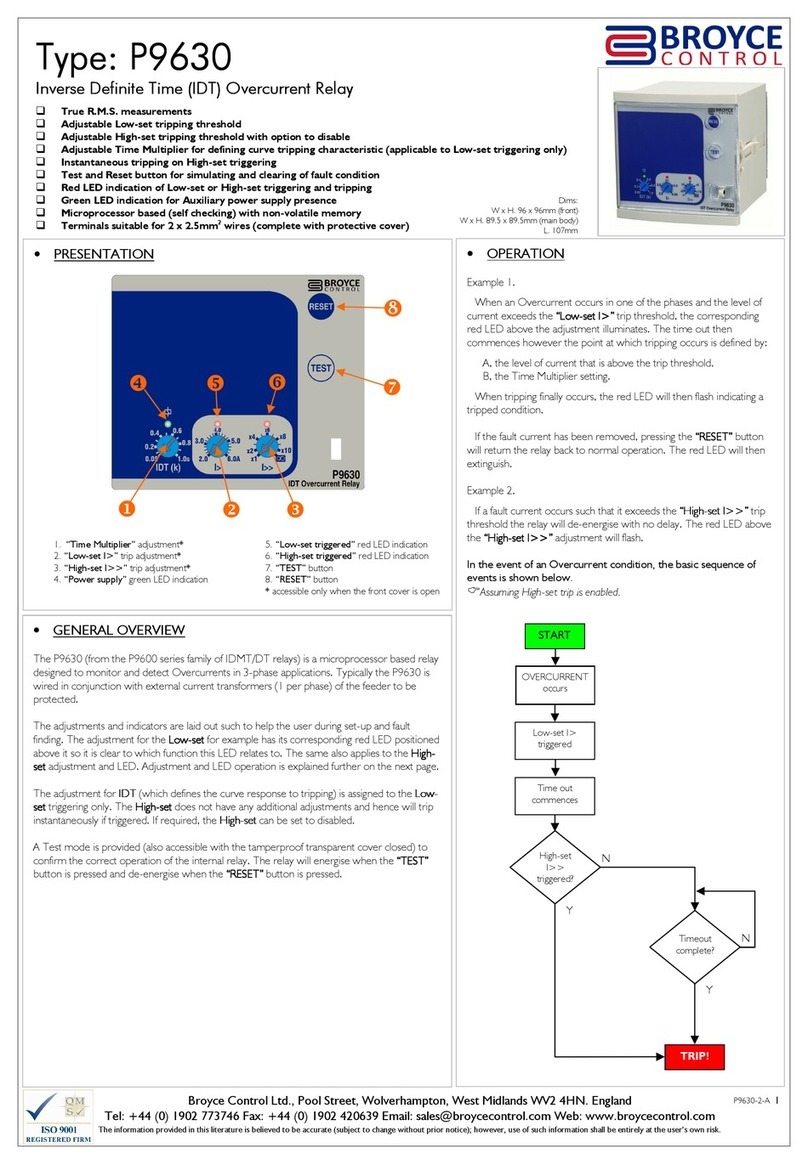
Broyce Control Ltd., Pool Street, Wolverhampton, West Midlands WV2 4HN. ngland
Tel: +44 (0) 1902 773746 Fax: +44 (0)
1902 420639
mail:
[email protected] Web: www.broycecontrol.com
The information provided in this literature is believed to be accurate (subject to change without prior notice); however, use of such information shall be entirely at the user’s own risk
.
P9670-2-A
3
33
3
7. QUICK VI W OF US R S TTINGS
It is not possible to edit settings when these screens are displayed.
This feature can also be activated with the front window closed!
•Press and hold the button to dis lay the initial ower u screen.
•Press the same button again to dis lay the “Last Tri ed Information” screen
(refer to the next section for further information on this feature).
•Press again to dis lay the “Overcurrent Summary” screen.
•Press again to dis lay the contact details for Broyce Control.
•Press again to revert back to Normal o eration.
8. LAST TRIPP D INFORMATION
Refer to next page for detailed information of this feature
Notes during programming
If during programming it is necessary to abort, press the button briefly.
Pressing and holding either or for >1sec. will increment or decrement
the new value at a quicker rate.
Stepping through each User Setting screen is performed by pressing and holding
the button until the desired screen is displayed.
Short presses of the button will allow further editable settings to be changed
within a specific screen.
If the user remains in a setting or summary screen where no adjustments or button
presses are made within a certain period, the screen will revert back to Normal
operation. Additionally, any settings that have been made but not stored will not be
saved.
“O/C” refers to Overcurrent.
•TRIPPING MOD
•A fault which develo s on a hase will be indicated by an increase in current
reading on the LCD. When the level of current exceeds the Low-set setting,
the hase at fault will be highlighted by the digits flashing.
•The LCD backlight will flash.
•Relay 2 will energise if assigned to Overcurrent and set to energise at the start
of the time out eriod (See Section 3. RELAY 2 SETTING).
•The characters “I>” will dis lay to indicate the Low-set has been triggered.
•If the current continues to increase above the High-set setting, the characters
“I>” will change and dis lay “I>>” to indicate the High-set has been
triggered.
•When the unit finally tri s, the digits of the hase at fault will sto flashing and
remain highlighted. This allows the user to see which hase was at fault and
caused the unit to tri .
•The red “Tri ed”
“Tri ed”“Tri ed”
“Tri ed” LED will also flash.
•The relays which energised are also dis layed on the screen after tri ing.
•Press to reset and return the unit back to normal o eration (assuming
the fault has been cleared). The LCD reverts back to dis laying the normal
system currents and the red “Tri ed”
“Tri ed”“Tri ed”
“Tri ed” LED sto s flashing.
If either relay is set for Auto resetting, then they would have de-energised after the
fault had cleared. The corresponding relay ident (i.e. R1 and/or R ) on the display
would also disappear. Pressing the “R
“R“R
“RESET”
ESET” ESET”
ESET” button will only clear the LCD. If either
relay is set for Manual resetting, then pressing the “RESET”
“RESET”“RESET”
“RESET” button will de-energise the
relay(s) and clear the LCD.
•PROGRAMMING (continued)
3. R LAY 2 S TTING
Default setting for Relay is to energise at the end of the time out period.
Resetting mode is Auto.
•Setting of “Relay 2”
“Relay 2”“Relay 2”
“Relay 2” is carried out in a similar manner as “Relay 1”
“Relay 1”“Relay 1”
“Relay 1”; however it
is necessary to assign the relay to either energise at the start (S) or end (E) of
the time out eriod.
Actual LCD resentation when adjustable arameters are dis layed.
•Press and hold the button to set the o tions for “
““
“OVERCURRENT”
OVERCURRENT” OVERCURRENT”
OVERCURRENT” as
described in the next section.
4. OV RCURR NT S TTING
The description for the Curves is abbreviated when displayed on the screen. Refer
to “IDMT Characteristic Curves” for further explanation.
Default settings for Overcurrent are shown in the last LCD screen example in this
section.
•Settings for Overcurrent are dis layed in turn following subsequent resses of
the button. The Low-set tri current (I>) is dis layed first.
•Press either or to change the current.
•Press the button to select the remaining settings and use the and
buttons to change them.
Actual LCD resentation when adjustable arameters are dis layed.
Screen exam le above also shows the default settings for OVERCURRENT.
•Press and hold the button to set the o tions for “
““
“EARTH FAULT”
EARTH FAULT” EARTH FAULT”
EARTH FAULT” as
described in the next section.
If the Curve in selection “ :” is set to Definite Time, then selection “3:” will display
“3: t>” and the required delay can then be set.
If High-set is set to Disable in selection “4:”, then I>> or t>> cannot be
adjusted.
5. OV RCURR NT SUMMARY
It is not possible to edit settings when this screen is displayed.
•Following the setting of “Overcurrent”, the LCD dis lays the “Overcurrent”
screen showing a summary of the settings made during rogramming. All
settings are dis layed. The selected CT ratio, Network Frequency and Relay
o eration (following a Reset) information is also dis layed.
6. SAVING OF S TTINGS
•If after viewing the Summary screen the settings are correct, ress and hold
the button until the word “
““
“Saved.
Saved.Saved.
Saved.”
””
” a ears. Any new settings are now
stored.
•The screen will revert back to Normal o eration.
I> 5.00A
NI 3/10
k> 0.1
I>>50.00A
t>>0.05s
R1 = MAN R2 = A TO (E)
RELAY 1: RELAY 2:
A TO A TO (E)
MAN MAN (E)
A TO (S)
MAN (S)
Low set
1: I> 5.00A
The letter in brackets refers to
whether Relay 2 has been set
to trigger at the start or end of
the time out eriod.
(E) = E
EE
End of time out
(S) = S
SS
Start of time out
Either abbreviation can a ear
after the word MAN or
AUTO
See Section 3. RELAY
SETTING
I
L1
20.70
A
I>
I
L2
40.00
A
I
L3
27.50
A
I
L1
20.70
A
I>>
I
L2
89.00
A R1 R2
I
L3
27.50
A
Low-set
triggered
High-set
triggered
Relay(s) which
energised on
tri ing
Low Set:
1: I> 5.00A
2: Curve NI 3/10
3: k> 0.1
High Set:
4: I>> 50.00A
